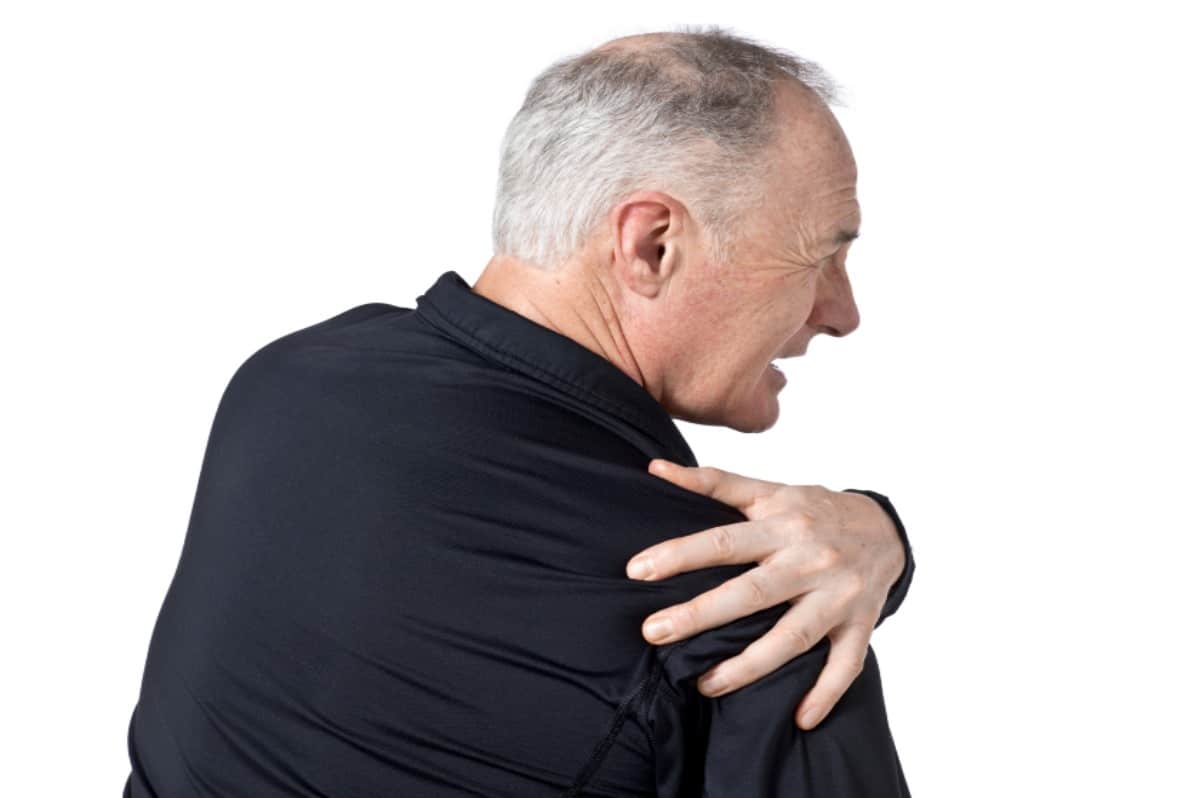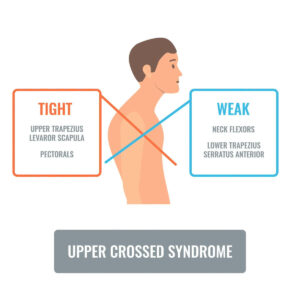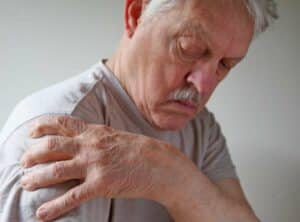Free download: Top 10 Natural & Easy Remedies for Joint Pain from Home. Learn these helpful remedies.
Do you ever get clicking or popping sounds in the shoulder? Even if it’s not painful, when this sound occurs it can definitely make you feel a little uneasy!
While shoulder clicking can be either pain-free or painful, you’ll want to try addressing it sooner than later.
Pain-free shoulder popping could be an early sign of a potential problem trying to develop, and painful shoulder popping, especially when related to a recent injury, could be a sign of a potentially serious issue.
The range of possibilities as to what could be causing clicking in the shoulder is pretty broad.
Let’s take a look at what could be causing this shoulder popping, treatment methods, and tips for maintaining a healthy shoulder joint.
Table of Contents
Shoulder Complex Overview
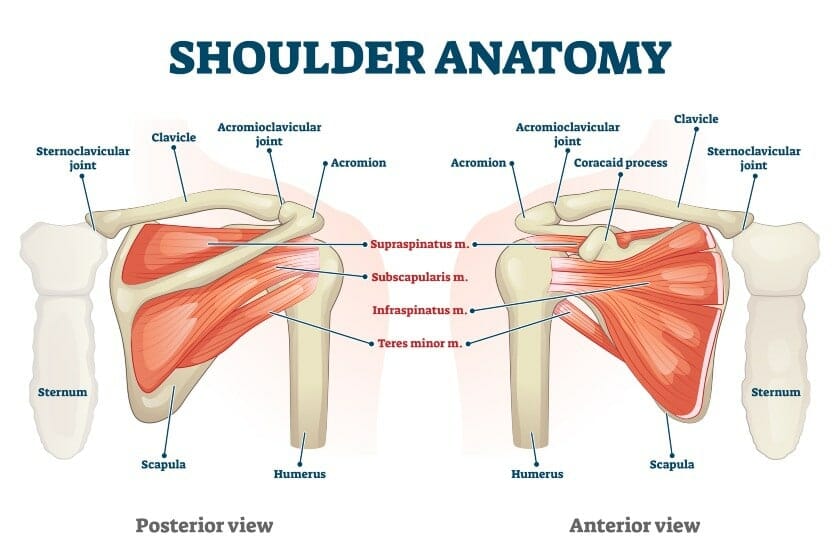
Welcome to shoulder anatomy 101!
While everyone is most familiar with the ball and socket joint, or glenohumeral joint, the entire shoulder complex is made up of multiple bony components and joints:
- Glenohumeral joint
- Sternoclavicular joint
- Acromioclavicular joint
- Scapulothoracic joint
The bony structures are surrounded by various soft tissues, both inside and outside the joints, that contribute to maximum mobility and stability in the shoulder. These structures include the following:
- Shoulder labrum
- Various muscles and their tendons, including the rotator cuff
- Shoulder joint cartilage
- Bursae sacs
- Various shoulder ligaments
- Synovial lining and synovial fluid
Having basic knowledge of the shoulder complex will help you to better understand possible underlying causes behind the shoulder popping.
Why Does My Shoulder Keep Popping?
We mentioned earlier that there can be both pain-free and painful occurrence of shoulder clicking or popping.
Another term for shoulder popping is shoulder crepitus. Did you know that when a joint makes a non-painful cracking sound, this very well could be a result of gas expansion within the joint? Interesting, right??
This gas expansion ends up placing a stretch on the joint, causing the popping sound. Some may even feel relief in the joint after this popping has occurred.
While gas expansion is just one explanation for shoulder joint popping, there are a variety of other possible conditions that may be causing non-painful or painful shoulder popping.
1. Arthritis
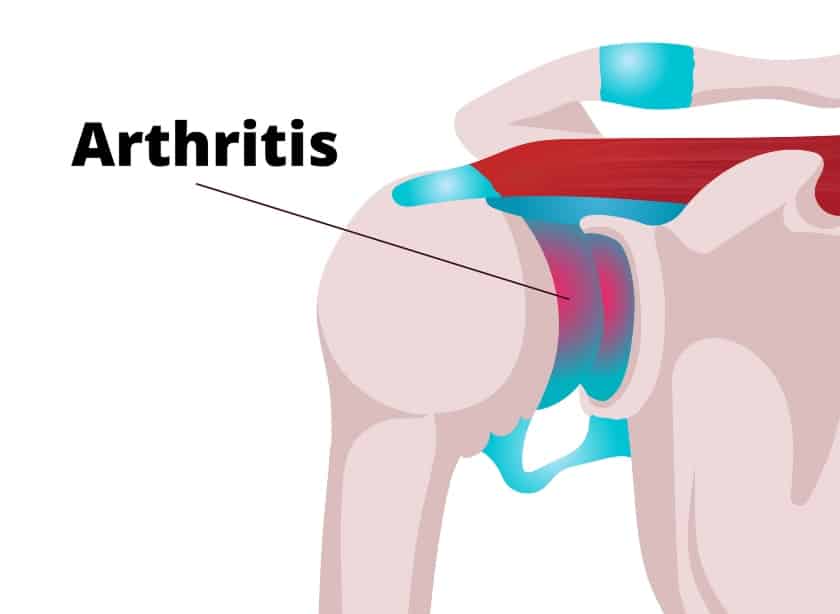
Arthritis can occur in any joint within the shoulder complex. It’s usually caused from progressive wear and tear within the joint over time.
These degenerative changes can cause increased friction forces and rubbing of the bony structures against each other during normal shoulder mobility.
In some cases, bony abnormalities, such as osteophytes or loose bony bodies, can form as a result.
Arthritis will usually cause the affected joint to feel stiff and achy. Your symptoms may feel worse after prolonged rest and then attempting to use the arm, such as when waking in the mornings.
The degenerative process and development of bony abnormalities can lead to a popping noise in the affected joint. This may or may not involve painful clicking.
2. Bursitis
Bursae are fluid filled sacs that cushion between bony structures and attaching soft tissues.
When these bursae become inflamed or irritated, often-times from repetitive stress or overuse injuries, bursitis can develop.
While overuse is a common cause of bursitis, it can also develop as a result of shoulder injuries.
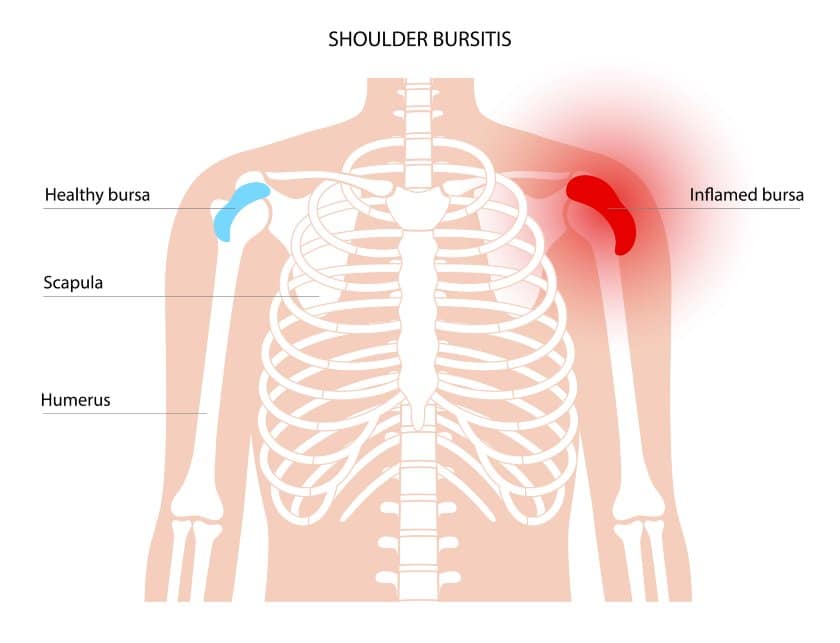
Due to inflammation and swelling occurring within the bursa, shoulder cracking with bursitis may be painful. Pain is common while continuing to use the arm, but likely will improve with rest.
3. Rotator Cuff Tendonitis
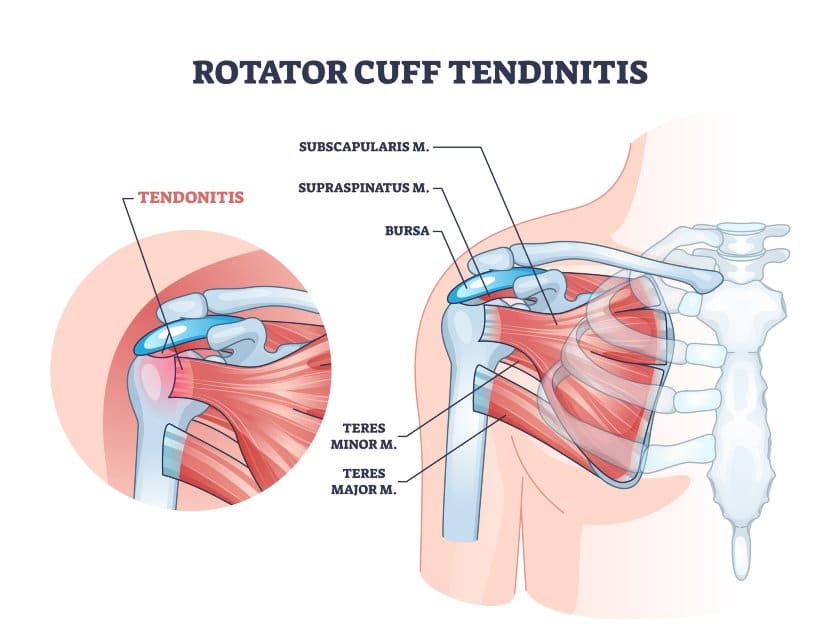
Realistically, any muscle/tendon unit that attaches to the shoulder complex has the potential to develop tendonitis; however, the rotator cuff, a group of four muscles, is a common victim of this overuse injury.
Tendonitis is another inflammatory response, similar to bursitis, commonly occurring as the result of an overuse injury. This is common in sports such as tennis, golf, football and baseball.
Keep in mind though, more serious shoulder injuries can also cause onset of rotator cuff tendonitis.
Tendonitis is usually worse the more you move the arm and improves with rest, with clicking in the shoulder a possible side effect while the arm is in motion.
4. Rotator Cuff Tears
Rotator cuff tears can vary in severity, ranging from mild to complete tears. These commonly occur as the result of an injury, such as a fall or sports injuries.
Rotator cuff tear symptoms can include shoulder weakness, increased pain when using the arm, some improvement but not able to achieve complete pain relief at rest and clicking when using the arm.
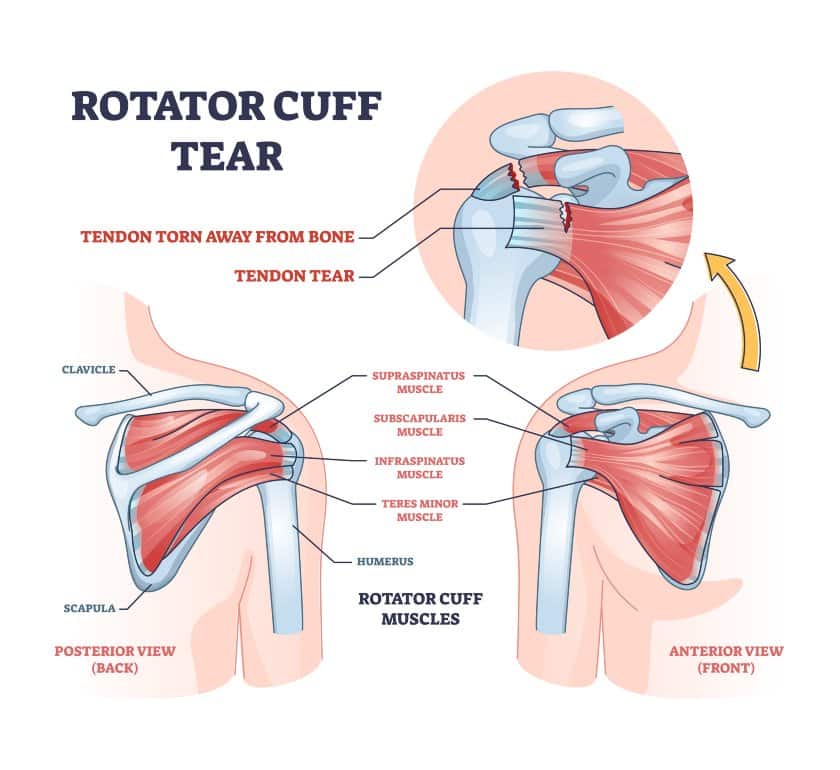
5. Snapping Biceps Tendon
The biceps tendon is located in the front of the humerus bone, or upper arm bone. A snapping biceps tendon can occur if the biceps tendon is moving in and out of its normal groove. This can lead to a shoulder snapping or popping sound.
Snapping biceps tendon could be occurring as a result of tendonitis or biceps instability. It’s common to experience painful clicking with this when moving the arm, especially overhead.
6. Shoulder Impingement

Shoulder impingement happens more often than you would think.
This shoulder disorder occurs when a bony structure at the top of the shoulder blade, called the acromion, begins to pinch or press on the rotator cuff.
Development of swelling and inflammation is a common cause for narrowing the space between the acromion and rotator cuff.
Shoulder impingement can occur as a result of an injury or from repetitive overhead motions.
Besides having a painful range of motion, which usually improves with rest, painful popping or clicking will commonly occur.
This pain and clicking is more prominent in certain directions, such as moving overhead and out to the side, and at certain points along your range.
7. Shoulder Labral Tear
The shoulder joint has a labrum lining the socket. The labrum, with assistance from surrounding ligaments, helps to ensure the shoulder remains in proper alignment.
A labral tear can occur as a result of ongoing repetitive overuse or a specific injury. When the labrum is loose in the shoulder joint, this can lead to popping or clicking.
Depending on the cause of labral tears, your shoulder clicking may be painful or pain-free. You may also experience decreased shoulder mobility and a higher risk of shoulder instability the longer you go on without addressing a labral tear.
8. Frozen Shoulder
Frozen shoulder is also known as adhesive capsulitis.
Frozen shoulder results from the gradual build-up of scar tissue within the shoulder joint cavity.
Depending on the stage of frozen shoulder you’re in, you may experience higher levels of pain at rest and/or when moving the arm and significantly restricted range of motion.

The cause of frozen shoulder isn’t fully well-understood; however, you can be at a higher risk if you have recently experienced a shoulder injury or surgery that has required the arm to be immobilized for a period of time with limited, if any, use.
With improvements and progress in regaining range of motion, you may notice shoulder clicking or popping, which may or may not have associated pain.
9. Snapping Scapula
A snapping scapula, or shoulder blade, is another possible cause for joint cracking. Like many of the other conditions already discussed, this particular scapula syndrome may have to do with repetitive, overused motions (e.g., athletes such as swimmers and baseball players).
This overuse can lead to swelling and inflammation, particularly around or in the bursa sac located between the scapula and ribs. You may feel the snapping scapula with any arm motion, but particularly when moving overhead or with rotation.
10. Fracture
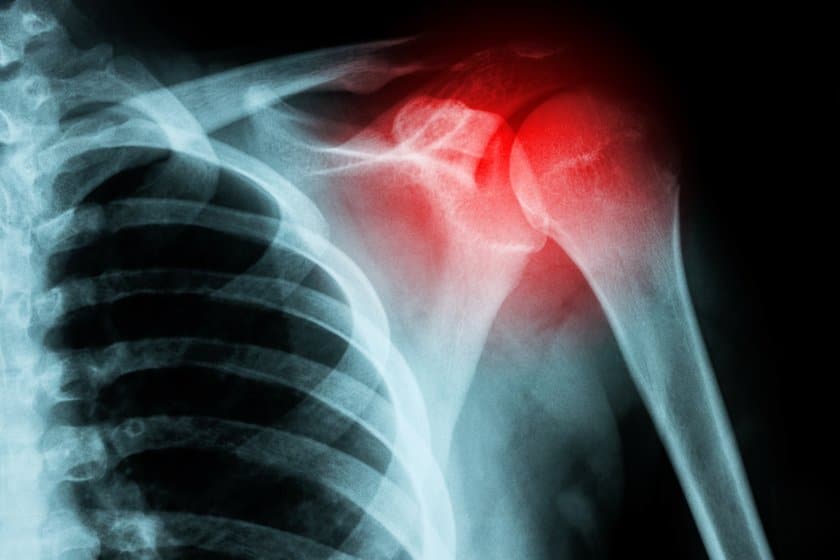
A fracture anywhere in the shoulder complex is a more severe shoulder condition. This is normally the result of a trauma, such as a fall or direct blow to the shoulder.
With a fracture, there is usually sudden sharp pain, very limited use of the injured arm, swelling and if unaware of your fracture, you may notice painful joint clicking or popping if you do try to move the arm.
11. Dislocated Shoulder
A shoulder dislocation is also considered a more severe shoulder condition. A dislocated shoulder joint will slide in and out of the socket, creating a significant amount of shoulder instability and pain.
Unless you have a condition that causes you to have excessive hypermobility, shoulder dislocations are commonly the result of an injury or trauma.

Damage or injury to the ligaments supporting and stabilizing the shoulder can make you more susceptible to a dislocation. With this instability, it’s common that the shoulder pops or clicks, and you likely will have pain.
Symptoms Associated with Shoulder Popping
While we briefly discussed symptoms of each individual diagnosis listed above, here is a brief overview of other common symptoms associated with shoulder popping:
- Decreased range of motion
- Arm weakness
- May or may not have arm pain
- Shoulder clicking or popping occurs during movement and improves with rest
- Grinding sensation in the shoulder
- Feeling of shoulder instability
An important note: If your shoulder popping is related to a recent injury, such as a fall or direct blow to the shoulder, it’s better to get it looked at by your doctor right away versus waiting for your symptoms to try and improve on their own.
Diagnosis of a Shoulder Condition
In order to properly diagnose why your shoulder is experiencing this popping sensation, you’ll need to see a doctor for a more thorough examination. An orthopedic specialist, who specializes in shoulder injuries, would be best.
During the examination, your doctor will first find out about your medical history and more details about your shoulder popping experience.
The physical exam will also include an assessment of any areas that are tender, range of motion, strength, and orthopedic special tests.
There are a variety of special tests that can be performed to further determine the cause of your shoulder popping. To give you a better idea of the range of special testing available, the following are just a few examples of the many special tests able to be performed, which will allow the doctor to rule in or out certain diagnoses:
- Hawkins-Kennedy test for shoulder impingement
- Load and Shift test for shoulder joint instability
- Crank test for a labral tear
- Drop arm test for possible rotator cuff tear
- Yergasons test for biceps tendon injury or labral tear
Again, these are just a few examples of some commonly used orthopedic special tests for various shoulder diagnoses.
Your doctor may additionally order imaging to further assess the shoulder, such as an X-ray, CT scan or MRI.
Treatment Plan
Once the proper diagnosis has been made to explain why your shoulder makes this popping sound, then the right treatment plan can commence.
Your doctor may recommend one or more of the following treatment options, depending on what your shoulder diagnosis is:
- R.I.C.E. (Rest, Ice, Compress, Elevate)
- Anti inflammatory medications
- Activity modification
- Physical therapy or Occupational therapy
- Possible surgery
If the cause behind your shoulder clicking or popping, with high levels of associated pain, involves a serious injury such as a fracture or soft tissue tear, then surgery may be necessary. In a case like this, if you haven’t consulted with an orthopedic surgeon, you will need to.
Exercises for Shoulder Popping
The right type of exercise routine can be very helpful for shoulder popping.
If the cause behind your shoulder popping isn’t related to a trauma or injury and isn’t painful, the purpose of exercise will be more for proactivity to ensure continuous shoulder health and stability.
If the cause behind your shoulder popping is related to a painful injury, then the type of exercise you can do will depend on your exact diagnosis and if a surgical repair was involved.
Getting help and guidance from an orthopedic and rehab specialist is one of the best things you can do for your shoulder popping.
Let’s take a look at some common exercises you will likely encounter when trying to address shoulder clicking and popping.
1. Shoulder External Rotation
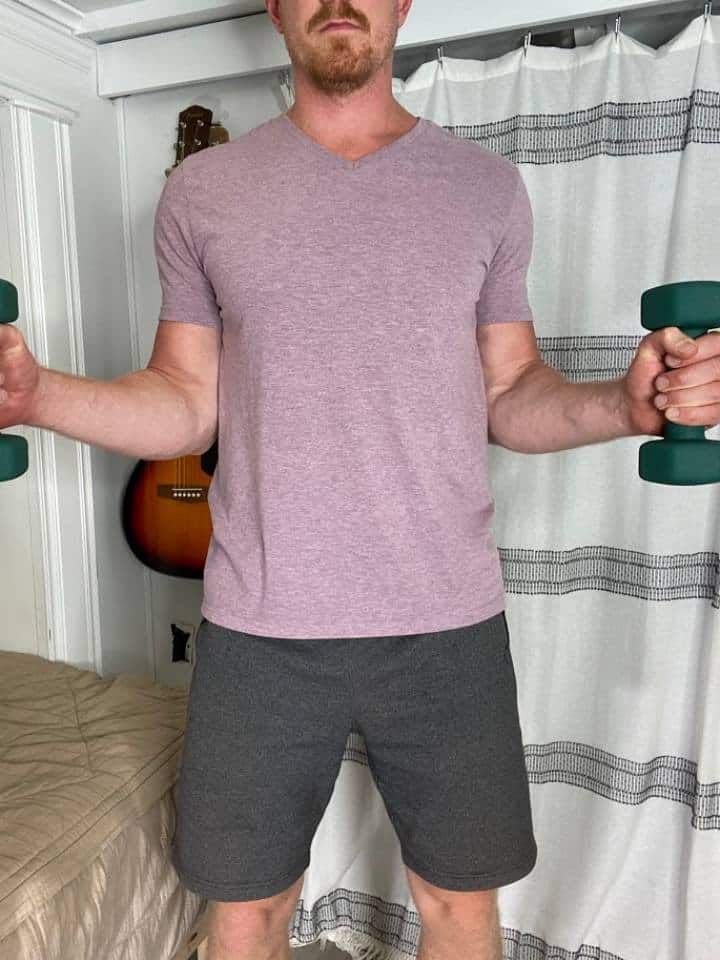
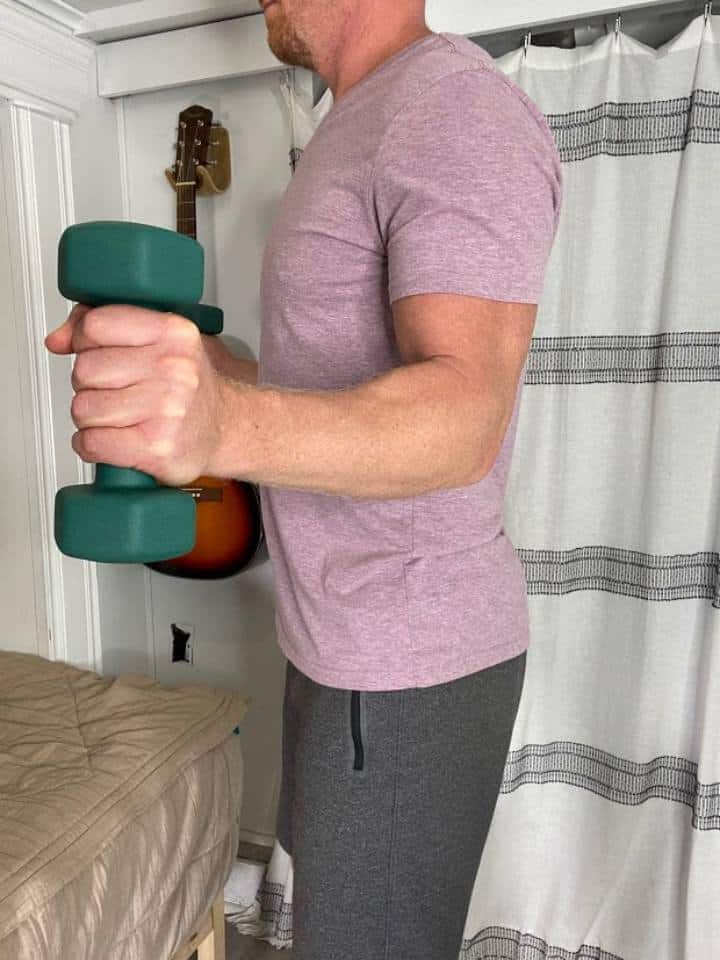
- You can use a free weight (1-3#) or a resistance band (light or medium resistance) for this exercise. You can perform this on one shoulder at a time, but simultaneously with both shoulders is a little more efficient if you’re able to do so.
- Holding your choice of weight or resistance, begin with the upper arms tucked by your side and the elbows bent 90 degrees. The palms should be facing each other.
- Keeping a nice, tall posture and squeezing the shoulder blades together, open the forearms away from each other (don’t let the upper arms move away from your torso).
- Hold for 2 seconds, then return to your starting position.
- Repeat 10-15x for 2-3 sets.
2. Shoulder Internal Rotation
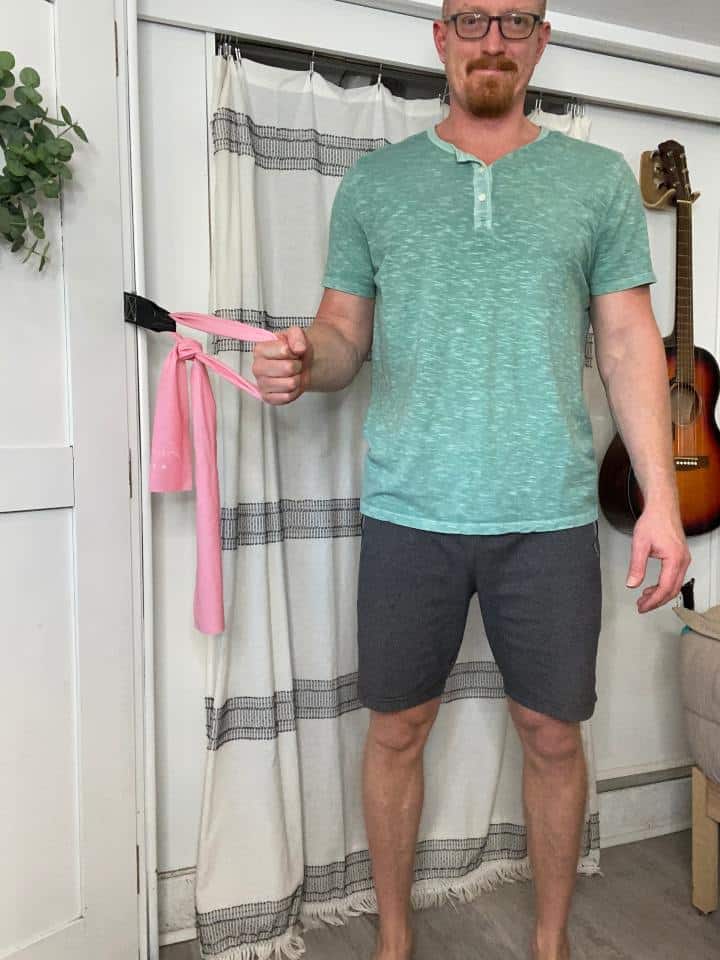
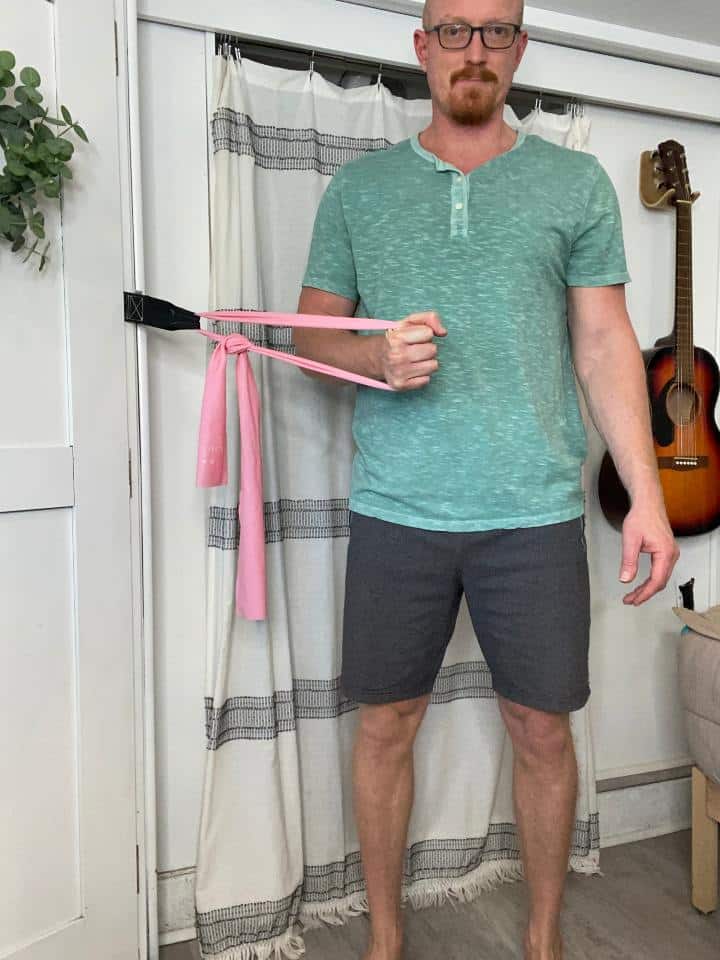
Shoulder internal rotation is the opposite motion of external rotation. Both motions involve activation of various muscles involved in stabilizing the shoulder, such as the rotator cuff.
- For shoulder internal rotation, you can again choose to use free weights (1-3#) or a resistance band.
- If using a resistance band, you’ll need to practice this on one arm at a time due to the direction you’ll be moving, which will be opposite of shoulder external rotation. The band will also need to be attached to a secure location, like a doorknob, in order to perform the correct motion.
- Position the arms like you did with shoulder external rotation. Elbows bent 90 degrees and tucked by your side. Palms facing each other.
- Keeping an upright posture, move the hand/s in towards your stomach.
- Hold for 2 seconds, then return to your starting position.
- Repeat 10-15x for 2-3 sets.
Helpful hint: Sometimes it’s easy to confuse shoulder internal and external rotation with each other.
Let’s take a look at this video to really see the difference between the two motions. While you technically can use free weights or a resistance band for these, we’ll demonstrate using a resistance band, as the set up with using a band for internal rotation will be a little different than for external rotation.
3. Shoulder Horizontal Abduction
Similar to shoulder external rotation, you can use a free weight (1-3#) or a resistance band (light or medium resistance) for this exercise. You can perform this on one shoulder at a time, but simultaneously with both shoulders is a little more efficient if you’re able to do so.
- Holding your choice of weight or resistance, stand tall with the arms stretched in front of you at 90-degrees shoulder height. The palms should be facing each other.
- Keep an upright posture and squeeze the shoulder blades together as the arms open away from each other. Open as far as you can without pain but avoid going beyond neutral alignment with the shoulders.
- Hold for 2 seconds, then return to your starting position.
- Repeat 10-15x for 2-3 sets.
4. Serratus Punch
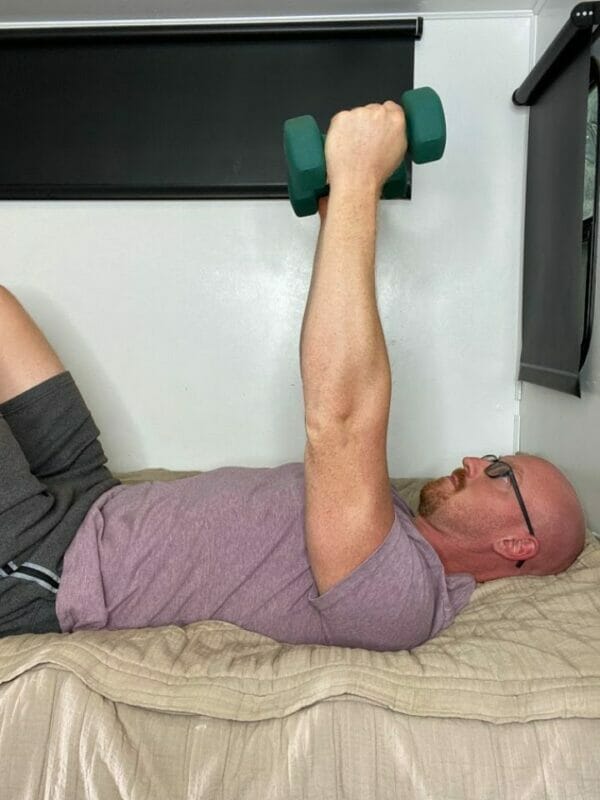
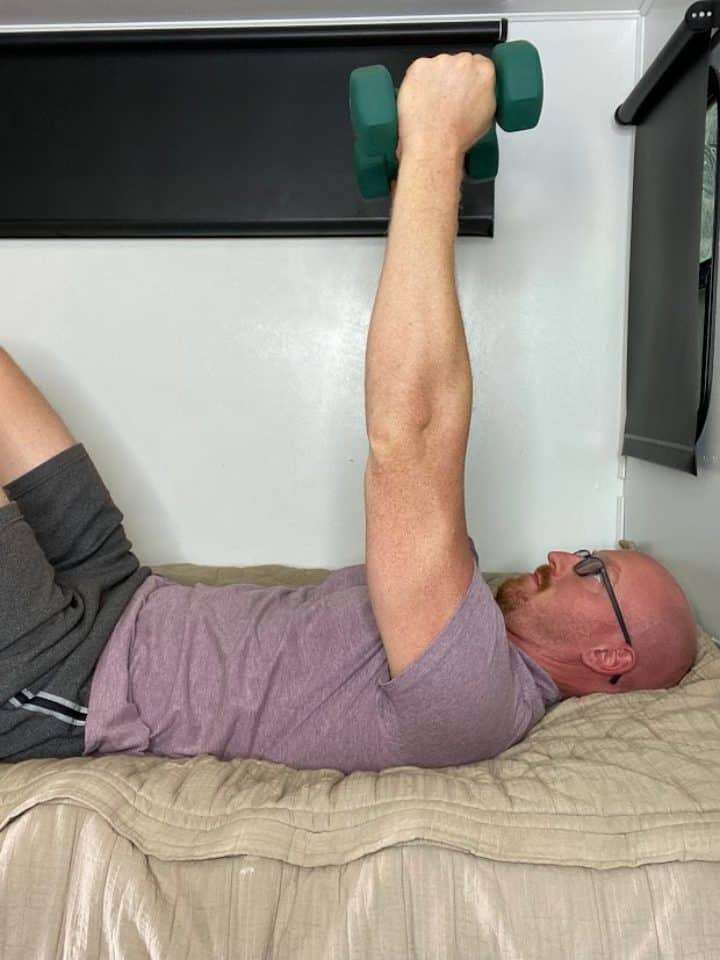
A serratus punch works the serratus anterior muscle.
- You’ll want to use free weights for this (1-3#). If you don’t have free weights, you can get creative and use other weighted objects, such as canned food items.
- Laying on your back (e.g., bed, couch or floor), while holding your weighted items, stretch the arms to the ceiling. Have the knees bent and the feet flat on the surface to support the back. Keep the palms facing each other.
- While keeping the arms straight, punch directly up towards the ceiling, while simultaneously lifting the shoulder blades off the floor (this will be a small movement).
- Hold for 2 seconds, then return to your starting position.
- Repeat 10-15x for 2-3 sets.
If you want to get creative with activating this same muscle group in an upright position versus laying down, you can practice a wall pushup plus. It combines a simple wall pushup with a small rounding of the upper back and shoulder blades at the end of the pushup, similar to the motion of the serratus punch.
Here’s a video to demonstrate an alternative wall pushup plus.
Tips for Maintaining Shoulder Health
While clicking and popping in the shoulder isn’t always associated with shoulder pain and injury, it still isn’t something to ignore. Your shoulder could very well be telling you that it needs a little more support and TLC!
Maintaining healthy shoulders is essential for our day-to-day living, if we want to be able to move about without any restrictions.
With this in mind, here are a few general tips for maintaining good shoulder health:
1. Posture
We can’t talk enough about posture!
Having good posture in both sitting and standing is vital for encouraging complete shoulder health. This is especially true if you work at a desk most, if not all, of the day and find yourself ending up slumped forward.
Proper posture and work ergonomics can be a great tool for keeping the shoulders in tip top shape. To understand more about the right and wrong way to sit at your workstation, check out the video below.
2. Sleeping Position
Positioning your shoulders in a neutral, supportive manner can really take a good amount of stress away from them overnight. Plus, in the mornings you’ll likely experience less stiffness and aching having positioned the shoulders the right way while sleeping.
Generally speaking, the best positions would be on your back with a pillow under the arm or laying on your side (try to avoid laying on the side of pain or on the shoulder experiencing the popping) with a pillow under the top arm for best support.
3. Don’t Push Beyond Your Limits
Don’t force your shoulders into doing something they clearly aren’t meant to do. If a position or motion feels uncomfortable or even painful, do not force this! No pain, no gain isn’t a good saying to live by.
If you’re doing an exercise through a certain range, and that range is too uncomfortable… modify it! If you’re using a certain amount of resistance that feels too straining… modify it!
Make any and all adjustments as needed.
4. Rest
If part of your problem is overusing the shoulders, then you may simply need to rest the shoulders from that particular activity for a few days at the first sign that something is off. This sign could be an increasing amount of shoulder popping with or without pain.
5. Keep a Healthy Exercise Routine
Don’t just utilize exercise when a problem starts. Make participating in a healthy exercise routine for your shoulders a natural habit!
By doing so, you’ll be taking a more proactive approach with your shoulder health, which can reduce your chances of injury and slow down natural wear and tear that likes to creep up over time.
Now, let’s get those shoulders healthy!
FAQ:
Should I wear a sling if my shoulder keeps popping?
Unless you’ve been instructed by your doctor because of a serious injury or surgery, no.
It’s important to keep actively using the arm as much as you can, but depending on your popping symptoms, you may have to modify your activity level while addressing the popping.
How long will it take to see improvements in my shoulder popping?
It all depends on the cause of your shoulder popping, but after you start working with the right shoulder specialist and begin and appropriate treatment plan, you could start seeing results in just a few weeks’ time.
Surgical repairs will usually require a few to several months of recovery, depending on the procedure performed.
Can I still play sports if my shoulder is popping?
As long as your sport isn’t causing pain or worsening of your shoulder popping, then yes. If you start noticing pain or an increased amount of popping, then you may want to hold on that sporting activity, until you can get your symptoms addressed.


